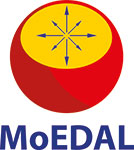MoEDAL releases new mass limits for the production of monopoles
 In April, the MoEDAL collaboration submitted its first physics-research publication on the search for magnetic monopoles utilising a 160 kg prototype MoEDAL trapping detector exposed to 0.75 fb–1 of 8 TeV pp collisions, which was subsequently removed and monitored by a SQUID magnetometer located at ETH Zurich. This is the first time that a dedicated scalable and reusable trapping array has been deployed at an accelerator facility.
In April, the MoEDAL collaboration submitted its first physics-research publication on the search for magnetic monopoles utilising a 160 kg prototype MoEDAL trapping detector exposed to 0.75 fb–1 of 8 TeV pp collisions, which was subsequently removed and monitored by a SQUID magnetometer located at ETH Zurich. This is the first time that a dedicated scalable and reusable trapping array has been deployed at an accelerator facility.

Figure 1. Cross-section upper limits at 95% confidence level for DY monopole production as a function of mass for spin-1/2. The various line styles correspond to different monopole charges. The solid lines are DY cross-section calculations at leading order. Image credit: MoEDAL Collaboration.
The innovative MoEDAL detector employs unconventional methodologies designed to search for highly ionising messengers of new physics such as magnetic monopoles or massive (pseudo-)stable electrically charged particles from a number of beyond-the-Standard-Model scenarios. The largely passive MoEDAL detector is deployed at point 8 on the LHC ring, sharing the intersection region with LHCb. It employs three separate detector systems. The first is comprised of nuclear track detectors (NTDs) sensitive only to new physics. Second, it is uniquely able to trap particle messengers of physics from beyond the Standard Model, for further study in the laboratory. Third, MoEDAL’s radiation environment is monitored by a TimePix pixel-detector array.
Clearly, a unique property of the magnetic monopole is that it has magnetic charge. Imagine that a magnetic monopole traverses the superconducting wire coil of a superconducting quantum interference device (SQUID). As the monopole approaches the coil, its magnetic charge drives an electrical current within the superconducting coil. The current continues to flow in the coil after the monopole has passed because the wire is superconducting, without electrical resistance. The induced current depends only on the magnetic charge and is independent of the monopole’s speed and mass.
In the early 1980s, Blas Cabrera was the first to deploy a SQUID device in an experiment to directly detect magnetic monopoles from the cosmos. The MoEDAL detector can also directly detect magnetic charge using SQUID technology, but in a different way. Rather than the monopole being directly detected in the SQUID coil à la Cabrera, MoEDAL captures the monopoles – in this case produced in LHC collisions – in aluminium trapping volumes that are subsequently monitored by a single SQUID magnetometer.
No evidence for trapped monopoles was seen in data analysed for MoEDAL’s first physics publication described here. The resulting mass limit for monopole production with a single Dirac (magnetic) charge (1gD) is roughly half that of the recent ATLAS 8 TeV result. However, mass limits for the production of monopoles with the higher charges 2gD and 3gD are the LHC’s first to date, and superior to those from previous collider experiments. Figure 1 shows the cross-section upper limits for the production of spin-1/2 monopoles by the Drell–Yan (DY) mechanism with charges up to 4gD. Additionally, a model-independent 95% CL upper limit was obtained for monopole charge up to 6gD and mass reaching 3.5 TeV, again demonstrating MoEDAL’s superior acceptance of higher charges.
Despite a relatively small solid-angle coverage and modest integrated luminosity, MoEDAL’s prototype monopole trapping detector probed ranges of charge, mass and energy inaccessible to the other LHC experiments. The full detector system containing 0.8 tonnes of aluminium trapping detector volumes and around 100 m2 of plastic NTDs was installed late in 2014 for the LHC start-up at 13 TeV in 2015. The MoEDAL collaboration is now working on the analysis of data obtained from pp and heavy-ion running in 2015, with the exciting possibility of revolutionary discoveries to come.
